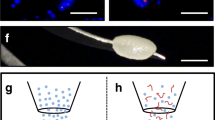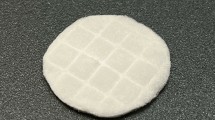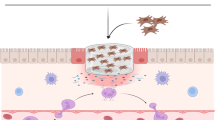Abstract
Diabetes can impair neovascularization important for wound healing, and this study investigated the hypothesis that this effect can be reversed by an active provisional matrix. Here, a 3D collagen scaffold and uncultured adipose-derived SVFs were firstly utilized to construct a collagen-targeting system for wound healing in a diabetic porcine model. The diabetic porcine models were made by injected streptozocin (STZ) intravenously and removed full thickness skin from the dorsum. Each animal received four different samples: Group A (control groups, n=24), Group B (SVFs groups, n=24), Group C (scaffold groups, n=24), Group D (SVFs -scaffold groups, n=24). PBS was applied to the wounds in Group A. 1×105 SVFs suspended in PBS were sprayed on the wounds in Group B. Scaffolds only with PBS were covered on the wounds in Group C. Scaffolds with equal volume of cell suspension containing 1×105 SVFs were covered on the wounds in Group D. The healing rates were calculated and compared among the groups and the tissues of the wound were taken and evaluated for histological analysis. The diabetic wound treated with the SVFs -collagen scaffold showed a significant decrease in wound size, an increase of neovascularization and a maximum VEGF and bFGF expression in comparison with SVFs and scaffold alone. The SVFs -collagen scaffold accelerates wound healing since it stimulates higher capillary formation causes major proangiogenesis factors expression in diabetic pigs suffering from skin defects, suggesting this approach could have utility for diabetic wound healing.
Similar content being viewed by others
References
D Goodridge, E Trepman, J Sloan, et al., Quality of life of adults with unhealed and healed diabetic foot ulcers, Foot Ankle Int, 27, 274 (2006).
D Marcelo, PM Beatriz, R Jussara, et al., Tissue therapy with autologous dermal and epidermal culture cells for diabetic foot ulcers, Cell Tissue Bank, 13, 241 (2011).
J Vojtass‡k, L Danisovic, M Kubes, et al., Autologous biograft and mesenchymal stem cells in treatment of the diabetic foot, Neuro Endocrinol Lett 27 Suppl,2, 134 (2006).
TT van Sloten, SA Friederichs, MS Huijberts, et al., Diabetic foot: new insights into pathophysiology and treatment, Ned Tijdschr Geneeskd, 152, 2400 (2008).
YR Kuo, CT Wang, JT Cheng, et al., Bone marrow-derived mesenchymal stem cells enhanced diabeticwound healing through recruitment of tissue regeneration in a rat model of streptozotocin-induced diabetes, Plast Reconstr Surg, 128, 872 (2011).
EK Kim, G Li, TJ Lee, et al., The effect of human adiposederived stem cells on healing of ischemic wounds in a diabetic nude mouse model, Plast Reconstr Surg, 128, 387 (2011).
JY Kim, JY Kim, SH Song, et al., Human cord blood-derived endothelial progenitor cells and their conditioned media exhibit therapeutic equivalence for diabetic wound healing, Cell Transplant, 19, 1635 (2010).
F Lu, H Mizuno, CA Uysal, et al., Improved viability of random pattern skin flaps through the use of adipose-derived stem cells, Plast Reconstr Surg, 121, 50 (2008).
MK Maharlooei, M Bagheri, Z Solhjou, et al., Adipose tissue derived mesenchymal stem cell (AD-MSC) promotes skin wound healing in diabetic rats, Diabetes Res Clin Pract, 93, 228 (2011).
L Sheng, M Yang, H Li, et al., Transplantation of adipose stromal cells promotes neovascularization of random skin flaps, Tohoku J Exp Med, 224, 229 (2011).
SK Han, HR Kim, WK Kim, et al., The treatment of diabetic foot ulcers with uncultured, processed lipoaspirate cells: a pilot study, Wound Repair Regen, 18, 342 (2010).
L Zimmerlin, VS Donnenberg, ME Pfeifer, et al., Stromal vascular progenitors in adult human adipose tissue, Cytometry A, 77, 22 (2010).
WS Kim, BS Park, SH Park, et al., Antiwrinkle effect of adiposederived stem cell: activation of dermal fibroblast by secretory factors, J Dermatol Sci, 53, 96 (2009).
BS Park, KA Jang, JH Sung, et al., Adipose-derived stem cells and their secretory factors as a promising therapy for skin aging, Dermatol Surg, 34, 1323 (2008).
WS Kim, BS Park, JH Sung, et al., The wound-healing and antioxidant effects of adipose-derived stem cells, Expert Opin Biol Ther, 9, 879 (2009).
Y Wu, L Chen, PG Scott, et al., Mesenchymal stem cells enhance wound healing through differentiation and angiogenesis, Stem Cells, 25, 2648 (2007).
SP Boudko, J Engel, et al., Structure formation in the C terminus of type III collagen guides disulfide cross-linking, J Mol Biol, 335, 1289 (2004).
S Liu, H Zhang, X Zhang, et al., Synergistic angiogenesis promoting effects of extracellular matrix scaffolds and adiposederived stem cells during wound repair, Tissue Eng Part A, 17, 725 (2011).
J Wang, W Cui, J Ye, et al., A cellular delivery system fabricated with autologous BMSCs and collagen scaffold enhances angiogenesis and perfusion in ischemic hind limb, J Biomed Mater Res A, 100, 1438 (2012).
S Balaji, SS Vaikunth, SA Lang, et al., Tissue-engineered provisional matrix as a novel approach to enhance diabetic wound healing, Wound Repair Regen, 20, 15 (2012).
V Falanga, et al., Wound healing and its impairment in the diabetic foot, Lancet, 366, 1736 (2005).
H Brem, M Tomic-Canic, et al., Cellular and molecular basis of wound healing in diabetes, J Clin Invest, 117, 1219 (2007).
R Blakytny, E Jude, et al., The molecular biology of chronic wounds and delayed healing in diabetes, Diabet Med, 23, 594 (2006).
V Falanga, S Iwamoto, M Chartier, et al., Autologous bone marrow-derived cultured mesenchymal stem cells delivered in a fibrin spray accelerate healing in murine and human cutaneous wounds, Tissue Eng, 13, 1299 (2007).
F De Francesco, V Tirino, V Desiderio, et al., Human CD34/CD90 ASCs are capable of growing as sphere clusters, producing high levels of VEGF and forming capillaries, PLoS One, 4, e6537 (2009).
SD Lin, SH Huang, YN Lin, et al., Engineering adipose tissue from uncultured human adipose stromal vascular fraction on collagen matrix and gelatin sponge scaffolds, Tissue Eng Part A, 17, 1489 (2011).
AJ Singer, RA Clark, et al., Cutaneous wound healing, N Engl J Med, 341, 738 (1999).
K Yoshimura, K Sato, N Aoi, et al., Cell-assisted lipotransfer for facial lipoatrophy: efficacy of clinical use of adipose-derived stem cells, Dermatol Surg, 34, 1178 (2008).
K Yoshimura, K Sato, N Aoi, et al., Cell-assisted lipotransfer for cosmetic breast augmentation: supportive use of adiposederived stem/stromal cells, Aesthetic Plast Surg, 32, 48 (2008)
M Sumi, M Sata, N Toya, et al., Transplantation of adipose stromal cells, but not mature adipocytes, augments ischemiainduced angiogenesis, Life Sci, 80, 559 (2007).
N Ferrara, K Alitalo, et al., Clinical applications of angiogenic growth factors and their inhibitors, Nat Med, 5, 1359 (1999).
C Rinsch, P Quinodoz, B Pittet, et al., Delivery of FGF-2 but not VEGF by encapsulated genetically engineered myoblasts improves survival and vascularization in a model of acute skin flap ischemia, Gene Ther, 8, 523 (2001).
RJ Aviles, BH Annex, RJ Lederman, et al., Testing clinical therapeutic angiogenesis using basic fibroblast growth factor (FGF-2), Br J Pharmacol, 140, 637 (2003).
NP Fam, S Verma, M Kutryk, et al., Clinician guide to angiogenesis, Circulation, 108, 2613 (2003).
Author information
Authors and Affiliations
Corresponding authors
Additional information
These authors contributed equally to this paper.
Rights and permissions
About this article
Cite this article
Jiang, Y., Chen, B., Liu, Y. et al. Effect of collagen scaffold with adipose-derived stromal vascular fraction cells on diabetic wound healing: A study in a diabetic porcine model. Tissue Eng Regen Med 10, 192–199 (2013). https://doi.org/10.1007/s13770-013-0001-8
Received:
Revised:
Accepted:
Published:
Issue Date:
DOI: https://doi.org/10.1007/s13770-013-0001-8




